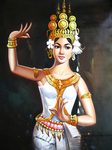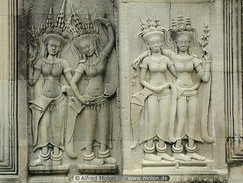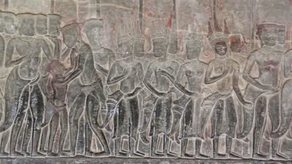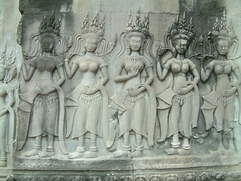what is an apsara?

An Apsara is a female spirit of the clouds and waters in Hindu and Buddhist mythology. They are broadly comparable to angels in Catholicism or Nereids in Greek mythology.
Apsaras in southeast asia
Apsaras are significant in Indonesian and Malay culture. Images of Apsaras are found in several temples of ancient Java, dating from the era of the Sailendra Dynasty to the Majapahit Empire. The Apsaras are usually integral parts of a story in bas-relief. In addition, bas-reliefs depicting Apsaras are also present in Angkor Wat, and this design is said to be at least 800 years old.
In Balinese culture, the theme of Apsaras often occurs, for example in dances such as Sanghyang Dedari and Legong. Apsaras are also often depicted as the wives of celestial musicians in Indonesia folklores and fairytales such as the "Story of Apsara Menaka". Since folktales are often reflective of a country's culture, the fact that Apsaras are often present shows that they are a prominent figure in Indonesian culture.
In Balinese culture, the theme of Apsaras often occurs, for example in dances such as Sanghyang Dedari and Legong. Apsaras are also often depicted as the wives of celestial musicians in Indonesia folklores and fairytales such as the "Story of Apsara Menaka". Since folktales are often reflective of a country's culture, the fact that Apsaras are often present shows that they are a prominent figure in Indonesian culture.
what does this have to do with indianisation?
The presence of Apsaras in Southeast Asian bas-reliefs shows that Hinduism and Buddhism were spread to Southeast Asia due to Indianisation. This is because Apsaras are from Hindu and Buddhist mythology, and hence indicate Hindu and Buddhist influence in the region. This means that Indianisation did indeed influence the society of Southeast Asia through the spread of religion.
Apsaras are also seen in Balinese culture, such as through traditional dances and folklore. This shows that not only did Indianisation influence the religions of Southeast Asia, it also had an influence over culture. Thus, it can be said that Indian influence was pervasive and prominent in the region.
Apsaras are also seen in Balinese culture, such as through traditional dances and folklore. This shows that not only did Indianisation influence the religions of Southeast Asia, it also had an influence over culture. Thus, it can be said that Indian influence was pervasive and prominent in the region.
Bas-Reliefs of Apsaras at Angkor Wat:
Legong Dance Performance with the theme of Apsaras:
Click here to continue.



